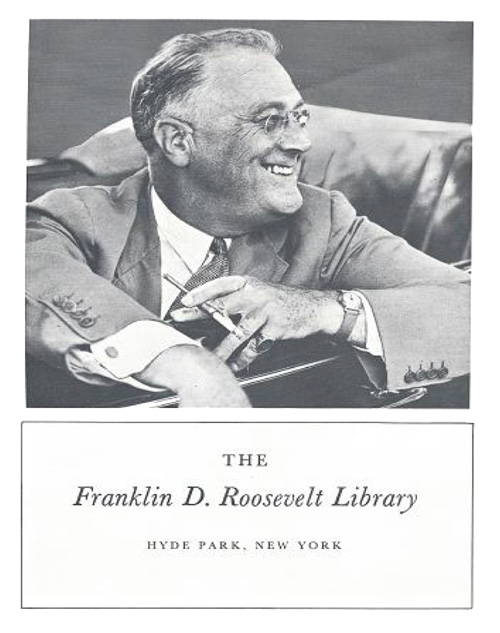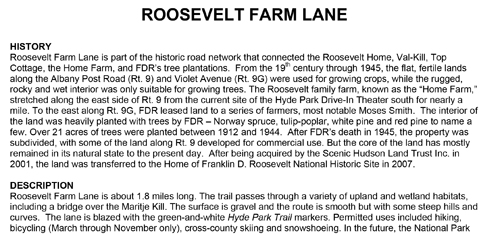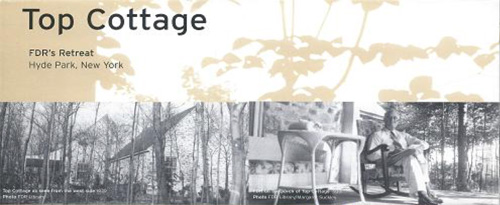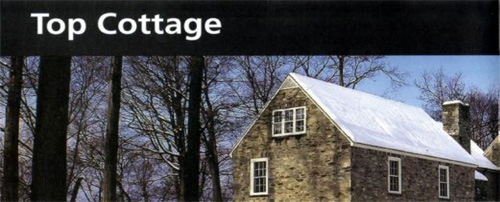|
Home of Franklin D. Roosevelt National Historic Site New York |
 |
 NPS photo | |
From his birth in 1882 Franklin Roosevelt belonged to a tight-knit group that valued tradition and continuity. A major player in the events of the 20th century and a man whose life was turned upside down by personal tragedy, Roosevelt was sustained by constants: a large family, old friends, and the house and grounds of Springwood. Franklin's father James, who bought the house in 1867, was seventh in a line of Roosevelts who were prominent members of New York City society. The Roosevelts had ties to the Hudson River Valley dating back to the 17th century, but it was not until 1818 that Franklin Roosevelt's great grandfather moved to the Hyde Park area. They were wealthy, though not on a scale with the neighboring Vanderbilts. In any case, James Roosevelt disapproved of ostentation, and Springwood was modest compared to many of the estates that lined the Hudson above New York.
Like other families of their class the Roosevelts spent the winter social season in New York City. They also owned a summer house on the Canadian island of Campobello, but Springwood was home. While James was a careful manager of his inherited wealth, making money was not the center of his life. He preferred to live the life of an English country squire—seeing to his horses and cattle, hunting, fishing, iceboating, and riding on the grounds. Sara shared James's affection for the place, declaring that the Roosevelts and other Hudson Valley gentry were "living life as it should be." To young Franklin, whose father passed on to him his love for the outdoors, the estate's woods and fields were paradise. Springwood remained the center of his life until he left for boarding school at 14. In his later years Franklin reminisced about his childhood here: "In thinking back to my earliest days. I am impressed by the peacefulness and regularity of things both in respect to place and people."
After James Roosevelt died in 1900, Sara and Franklin, then a freshman at Harvard, continued to live in the house. When he married Eleanor Roosevelt in 1905, the young couple moved in with Sara, in whose name the house remained until her death in 1941. Franklin's work and political career required that the family live elsewhere for long periods, but they returned to Springwood whenever possible. During his years as governor of New York and President, Springwood was the nucleus of his life and career. It was haven and political headquarters, and it was here that he entertained numerous dignitaries. Throughout his presidency he returned some 200 times for temporary respite from Washington and for the nourishment Springwood gave him. By 1944, though, ill and weary from the intensity of the war effort, there was a note of finality when he said: "All that is within me cries out to go back to my home on the Hudson River."
He was born into a rich and aristocratic family; he was educated by private tutors in the patrician environment of a Hudson Valley estate.
—Judge Samuel Rosenman, FDR associate
In 1867, 15 years before Franklin Roosevelt was born, his father James Roosevelt bought the house at Springwood. It was a large farmhouse built around 1800, but James, and later Sara and Franklin, transformed it into something grander. The previous owner had already built a three-story tower and a full-length covered porch. James added two rooms, enlarged the servants' wing, and built a large carriage house for his prized horses and carriages. In 1915 Franklin and his mother added a tower on the right and large fieldstone wings, replaced the clapboard exterior with stucco, raised the pitched roof to create a flat-roofed third story, and replaced most of the porch with a large fieldstone terrace with balustrade and a small columned portico. Franklin also planted many varieties of trees on the grounds, eventually turning large sections of the estate into an experimental forestry station. Some of his work is still in evidence. The house, too, retains his stamp. Four times he stood on the terrace on election nights to greet well-wishers. When he was here, he conducted the business of the presidency from his office. In the main hall are his boyhood collection of stuffed birds and a bronze sculpture of him in 1911 when he was 29 and serving his first term in the New York State Senate. Formal entertaining took place in the Dresden Room and the Dining Room, while the family liked to gather in the more casual Living Room/Library. Here, too, Roosevelt could pursue his hobbies, poring over his stamp collection or building ship models. Upstairs is the Birth Room, with the bed in which he was born, and his Boyhood Bedroom, later used by each of his sons in turn. Prime Minister Winston Churchill and King George VI, among other notables, stayed in other rooms off the same hall. The bedroom he used as President remains as it was during his last stay in March 1945, shortly before his death. He loved this room, partly because of the beautiful view across the south lawn and down the Hudson River.
Up to the age of seven, Hyde Park was the center of my world.
—Franklin Delano Roosevelt
A Sheltered Life
His name and family connections gave him a decided advantage when he entered politics, yet the young Franklin Roosevelt did not seem destined for public office. His insulated upbringing provided little experience with the kinds of problems confronting the less affluent. Most young men in the Hudson Valley gentry were expected to go to college. They might then receive a grounding in law before managing the property they would inherit. Some went into business, became sportsmen, or thrived as full-time socialites, but politics was not usually an option. The idea of publicly soliciting votes went against the grain of many in Roosevelt's sheltered world, as did associating with politicians who sometimes had to operate in an ethically gray realm of deals and favors. Even the ascension to the presidency of Roosevelt's distant cousin Theodore Roosevelt did not wholly remove the stigma. Nevertheless Roosevelt chose politics, though many around him did not take his first campaign too seriously. Eventually he came to sympathize with and support working men and women.
As President he took what were in the 1930s considered almost radical steps to alleviate their suffering. Franklin Roosevelt was born January 30, 1882, to James Roosevelt and his wife Sara Delano, both of prominent Hudson River Valley families. Franklin was their only child together (James, a widower, had a son by his first wife), and they doted on him. The rural setting of his youth was a quiet enclave in a rapidly industrializing country. His early education was by governesses and tutors, giving him little contact with children his age other than neighbors and relatives. Franklin traveled frequently to Europe with his parents, lived in New York City during the winter months, and spent summers at Campobello.
He believed in the liberal cause because he believed in the dignity of man and in his right to a self-respecting life.
—Judge Samuel Rosenman, FDR associate
Becoming FDR
This idyllic, undemanding existence changed abruptly at age 14, when Franklin was sent to boarding school at Groton. The experience, though not always happy, was a crucial one. The educational philosophy of the school's headmaster, the Rev. Endicott Peabody, was based on his ideal of a robust Christianity—a healthy mind in a healthy body. Boys who excelled in football, something Franklin did not do, won his special favor. But Peabody expected more than athletic prowess. In exchange for the privileges and respect these boys had been taught was their birthright, they owed a duty to society, to the less fortunate. His moral teachings encouraged an emerging sense of social responsibility in the young Roosevelt.
At Harvard there were social disappointments, and Franklin's academic record was unremarkable. He did, however, make a niche for himself as editor of the Harvard Crimson, the school newspaper. He graduated in 1904, and the following year he married Anna Eleanor Roosevelt, niece of President Theodore Roosevelt. They rented a house in New York and started a family while Franklin attended Columbia Law School. Anna, the first of their six children and the only girl, was born in 1906. Franklin joined a prominent Wall Street law firm, but his heart was never in it. Inspired by his cousin Theodore, he dreamed of entering politics, tracing out a career that progressed almost exactly along the lines of the President's. It happened the way he predicted. In 1910 FDR won the attention of local Dutchess County politicians, who ran him on the Democratic ticket. He won a seat in the New York State Senate, where he showed the first trace of a reform temperament. He began attracting notice, helped somewhat by his name, and in 1913 President Woodrow Wilson named him Assistant Secretary of the Navy. He served in Washington through the war years, then ran for vice-president on the Democratic ticket with James Cox in 1920. They lost, but Roosevelt had stepped up onto the national stage.
His ascent was stalled by a devastating turn in what had been a charmed life. In 1921, at the age of 39, he contracted polio and never again walked unaided. Roosevelt's native optimism was for the first time severely tested, but reserves of strength unsuspected by others, perhaps even by himself, came into play. He labored through years of therapy, adapting mentally and physically to his condition. Eleanor also labored to keep his political career alive, writing countless letters, making contacts, traveling and becoming his eyes and ears in places he could not go. FDR reclaimed the political spotlight in 1924 with a memorable nominating speech for Al Smith at the Democratic national convention. His election as Governor of New York in 1928 and again in 1930 opened the door to the presidency.
I am an old campaigner and I love a good fight.
—Franklin Delano Roosevelt
I see an America whose rivers and valleys and lakes, hills and streams and plains, the mountains over our land . . . are protected as the rightful heritage of all the people.
—Franklin Delano Roosevelt
The President
When FDR was inaugurated on March 4, 1933, the country's prospects were grim. Millions in the work force—one in four—were unemployed. Most banks had closed their doors. Business activity was half what it had been in 1929. Crop prices were so low that thousands of farmers could not make a living, while others watched their topsoil erode, dry out, and blow away. Herbert Hoover had seemed helpless to combat the Depression, and all eyes were on the new President. FDR brought to the job qualities almost perfectly matched to the enormous task. He was relentlessly optimistic. In those early, dark days he helped to raise the spirit of the American people and convince them that their country was not on the verge of collapse, that they could again trust financial institutions with their money, that the problems were surmountable.
FDR was a complex man with contradictory qualities: an aristocrat with the common touch, a traditionalist who was willing to try anything, a jovial charmer who was deeply serious about his beliefs and the consequences of his actions. He was also a skilled political tactician with a fine sense of timing. No President made better use of his advisors, constantly absorbing, adapting, refining his responses, then finding the precise point of compromise. FDR mistrusted theories, systems, and political absolutes. In the face of opposition he held to his belief that in extraordinary times "bold, persistent experimentation" was the answer. The National Recovery Administration, National Labor Board, Civilian Conservation Corps, Works Progress Administration, TVA, Social Security, and other New Deal programs grew out of this belief. They were controversial, with fierce defenders and equally fierce critics, but all were grounded in personal ideals that had guided FDR from early in his political career.
When FDR was called on to lead a nation at war, he worked with the same focus and high spirits he had shown in dealing with economic crisis. Much of his effort went into building the alliance that defeated the Axis powers, using personal diplomacy in his dealings with Churchill and Stalin and other allied leaders. As the conflict drew to a close, FDR put his faith in the United Nations as the world's best hope for avoiding another global war. He was preparing his speech for the UN's charter conference when he died of a cerebral hemorrhage in Warm Springs, Georgia, on April 12, 1945. He was buried in the Rose Garden at Springwood in Hyde Park, N.Y.
I see one-third of a national ill housed, ill clad, ill nourished.
—Franklin Delano Roosevelt
The FDR Library
As Franklin Roosevelt neared the end of his second term he began thinking about the disposition of his papers. Earlier Presidents had taken their papers with them when they left office, or deposited them in an existing library. Roosevelt planned a new library for his, where they could be better protected and made accessible to scholars as part of the National Archives system. Roosevelt also wanted the library to preserve some of his books, his mementos of office, and his extensive collection of naval prints, paintings, and models. He also reserved one room for his study.
  (click for larger maps) |
Roosevelt was closely involved in the project: He donated 16 acres of the Springwood estate, designed the stone Dutch colonial building, and even helped to place the initial exhibits. Built by private subscription, the building was completed and turned over to the government in 1940. The museum was opened the following year and the archives in 1946. After Roosevelt was reelected to third and fourth terms, the study became his office away from the White House and the scene of conferences with world leaders and four of his fireside chats. This is the only presidential library that was used by a sitting President. After his death the library continued to grow. Two wings originally designed by Roosevelt were added in 1972 to house enlarged research facilities and a gallery devoted to the life of Eleanor Roosevelt. In addition to its 44,000 books, the library holds large collections of manuscripts, photographs, recordings, and film. Among the thousands of items on display in the museum are Roosevelt's cradle and his White House desk and chair. The library is administered separately by the National Archives and Records Administration.
The only limit to our realization of tomorrow will be our doubts of today. Let us move forward with strong and active faith.
—Franklin Delano Roosevelt
About Your Visit
President Roosevelt donated his home and 33 acres to the American people in 1943, on the condition that his family be allowed to use it after his death. It was transferred to the Department of the Interior on November 21, 1945, after the family relinquished their lifetime rights. The 290-acre national historic site is located on U.S. 9, six miles north of Poughkeepsie, N.Y. Contact: Home of Franklin D. Roosevelt National Historic Site, 4097 Albany Post Road, Hyde Park, NY 12538; www.nps.gov/hofr.
For Your Safety Please walk on the designated paths. Do not approach or attempt to feed any wildlife; cases of rabies have been reported in the area. There are poisonous snakes and plants. Ticks carrying Lyme disease have been found in Dutchess County.
Accessibility The home is wheelchair accessible; only two wheelchairs at a time can be accommodated on the second floor due to fire safety codes. Accommodations for large groups in wheelchairs, signing, or other special accommodations may be possible with advance arrangements. Accessible restrooms are nearby.
Source: NPS Brochure (2010)
|
Establishment Home of Franklin D. Roosevelt National Historic Site — January 15, 1944 |
For More Information Please Visit The  OFFICIAL NPS WEBSITE |
Brochures ◆ Site Bulletins ◆ Trading Cards

Documents
An Inventory of Terrestrial Mammals at National Parks in the Northeast Temperate Network and Sagamore Hill National Historic Site U.S. Geological Survey Scientific Investigations Report 2007-5245 (Andrew T. Gilbert, Allan F. O'Connell, Jr., Elizabeth M. Annand, Neil W. Talancy, John R. Sauer and James D. Nichols, 2008)
Cultural Landscape Report for Springwood, Volume II: Treatment, Home of Franklin D. Roosevelt National Historic Site (John Auwaerter, 2009)
Cultural Landscape Report for Bellefield, Home of Franklin D. Roosevelt National Historic Site (Kristen Holder, 2012)
Cultural Landscape Report: Franklin D. Roosevelt's Top Cottage (Elmore Design Collaborative, Inc., 2002)
Cultural Landscapes Inventory: Bellefield, Home of Franklin D. Roosevelt National Historic Site (2024)
Cultural Landscapes Inventory: Springwood, Home of Franklin D. Roosevelt National Historic Site (2022)
Cultural Landscapes Inventory: Top Cottage, Home of Franklin D. Roosevelt National Historic Site (2014)
Cultural Landscapes Inventory: Upland Farms, Home of Franklin D. Roosevelt National Historic Site (2022)
FDR and the Land: Roosevelt Estate Historic Resource Study, Home of Franklin D. Roosevelt National Historic Site FDR and Forestry: Private Passion, Public Policy/Country Place and Tree Farm: Land-Use History of the Roosevelt Estate (John E. Auwaerter, 2011)
Foundation Document, Home of Franklin D. Roosevelt National Historic Site, New York (September 2017)
Foundation Document Overview, Home of Franklin D. Roosevelt National Historic Site, New York (January 2017)
Franklin D. Roosevelt & Conservation 1911-1945 Volumes One and Two (Edgar B. Nixon, ed., 1957)
Franklin D. Roosevelt and Hyde Park: Personal Recollections of Eleanor Roosevelt (1949)
General Management Plan, Roosevelt-Vanderbilt National Historic Sites (2010)
Geologic Map of Roosevelt-Vanderbilt National Historic Sites (December 2023)
Geologic Resources Inventory Report, Roosevelt-Vanderbilt National Historic Sites NPS Science Report NPS/SR-2024/171 (Tim C. Henderson, August 2024)
Historic Structure Report, Home of Franklin D. Roosevelt National Historic Site, Hyde Park, New York: Architectural Data Section (Peggy A. Albee, written 1989, published 1996)
Junior Ranger Activity Book, The Home of Franklin D. Roosevelt (Date Unknown; for reference purposes only)
National Register of Historic Places Nomination Form
Home of Franklin Delano Roosevelt National Historic Site (Bronwyn Krog and Marlene Rockmore, April 5, 1979)
Natural Resource Condition Assessment for the Roosevelt-Vanderbilt National Historic Sites (ROVA) NPS Natural Resource Report NPS/NER/NRR-2012/557 (Charles Andrew Cole, Rebecca Wagner, Margaret C. Brittingham, C. Paola Ferreri, Larry Gorenflo, Margot W. Kaye, Brian Orland and Ken Tamminga, July 2012)
Park Newspaper (Hands on The Land): 2015
Topographic Map: Franklin D. Roosevelt National Historic Site, NY Scale: 1:960 (USGS, 1984)
The Home of Franklin D. Roosevelt, Hyde Park, New York, USA
Books

hofr/index.htm
Last Updated: 15-Nov-2024






















